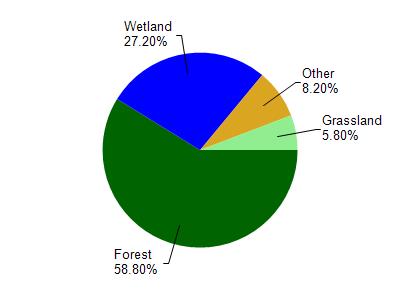Lincoln
No
No
No
Fish and Aquatic Life
Historical Description
Source: 1982, Surface Water Resources of Lincoln County Alexander Flowage, T31N, R6E. Sec. 5 Surface acres = 676.9, Maximum Depth = 36 feet, Secchi Disc = 4 feet.
A soft water drainage lake (impoundment) on the Wisconsin River, having slightly acid, medium brown water of low transparency. The shoreline is 99 percent upland consisting mostly of hardwoods. The small wetland is of coniferous bog. The littoral zone bottom materials are composed of 60 percent sand, 15 percent gravel, 15 percent silt and 10 percent rubble. Vegetation is moderate in density on about 20 percent of the flowage. The inlets, in addition to the Wisconsin River, are the Copper River and Joe Snow Creek. Fish inhabiting this lake are muskellunge, northern pike, walleye, perch, largemouth bass, bluegill, black crappie, rock bass and bullhead. Spring and fall migrant waterfowl make use of this lake. Muskrats are present. The water control structure is owned by the Wisconsin Public Service Corporation and has a head of 23 feet. Public access with parking is provided at the Council Grounds State Park and there is navigable water access by way of the Wisconsin and Copper rivers. There are 102 dwellings, one resort, a state campground, a picnic site, and park area on the shoreline.
Date 1982
Author Surface Water Inventory Of Wisconsin
Management Goals
Wisconsin's Water Quality Standards provide qualitative and quantitative goals for waters that are protective of Fishable, Swimmable conditions [Learn more]. Waters that do not meet water quality standards are considered impaired and restoration actions are planned and carried out until the water is once again fishable and swimmable
Management goals can include creation or implementation of a Total Maximum Daily Load analysis, a Nine Key Element Plan, or other restoration work, education and outreach and more. If specific recommendations exist for this water, they will be displayed below online.
Monitoring
Monitoring the condition of a river, stream, or lake includes gathering physical, chemical, biological, and habitat data. Comprehensive studies often gather all these parameters in great detail, while lighter assessment events will involve sampling physical, chemical and biological data such as macroinvertebrates. Aquatic macroinvertebrates and fish communities integrate watershed or catchment condition, providing great insight into overall ecosystem health. Chemical and habitat parameters tell researchers more about human induced problems including contaminated runoff, point source dischargers, or habitat issues that foster or limit the potential of aquatic communities to thrive in a given area. Wisconsin's Water Monitoring Strategy was recenty updated.
Grants and Management Projects
Monitoring Projects
| WBIC | Official Waterbody Name | Station ID | Station Name | Earliest Fieldwork Date | Latest Fieldwork Date | View Station | View Data |
|---|
| 1494600 | Alexander Lake | 10012366 | Alexander Lake | 5/7/1996 | 6/11/2025 | Map | Data |
| 1494600 | Alexander Lake | 353082 | Alexander Lake - Deep Hole | 8/8/1979 | 9/21/2022 | Map | Data |
| 1494600 | Alexander Lake | 353219 | Wisconsin River - Council Grounds State Park Beach | 6/16/2003 | 8/26/2025 | Map | Data |
|

Watershed Characteristics
Alexander Lake is located in the Prairie River watershed which is 263.99 mi². Land use in the watershed is primarily forest (58.80%), wetland (27.20%) and a mix of grassland (5.80%) and other uses (8.20%). This watershed has 273.14 stream miles, 2,082.78 lake acres and 34,162.59 wetland acres.
Nonpoint Source Characteristics
This watershed is ranked Medium for runoff impacts on streams, Medium for runoff impacts on lakes and Low for runoff impacts on groundwater and therefore has an overall rank of Low. This value can be used in ranking the watershed or individual waterbodies for grant funding under state and county programs.However, all waters are affected by diffuse pollutant sources regardless of initial water quality. Applications for specific runoff projects under state or county grant programs may be pursued. For more information, go to surface water program grants.